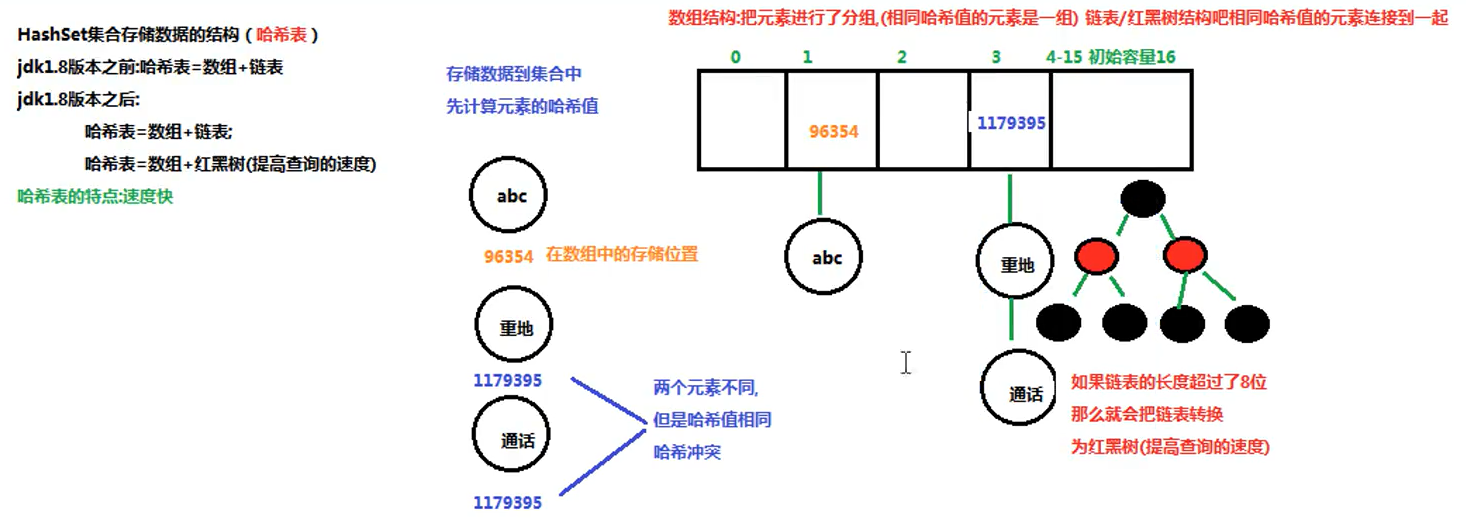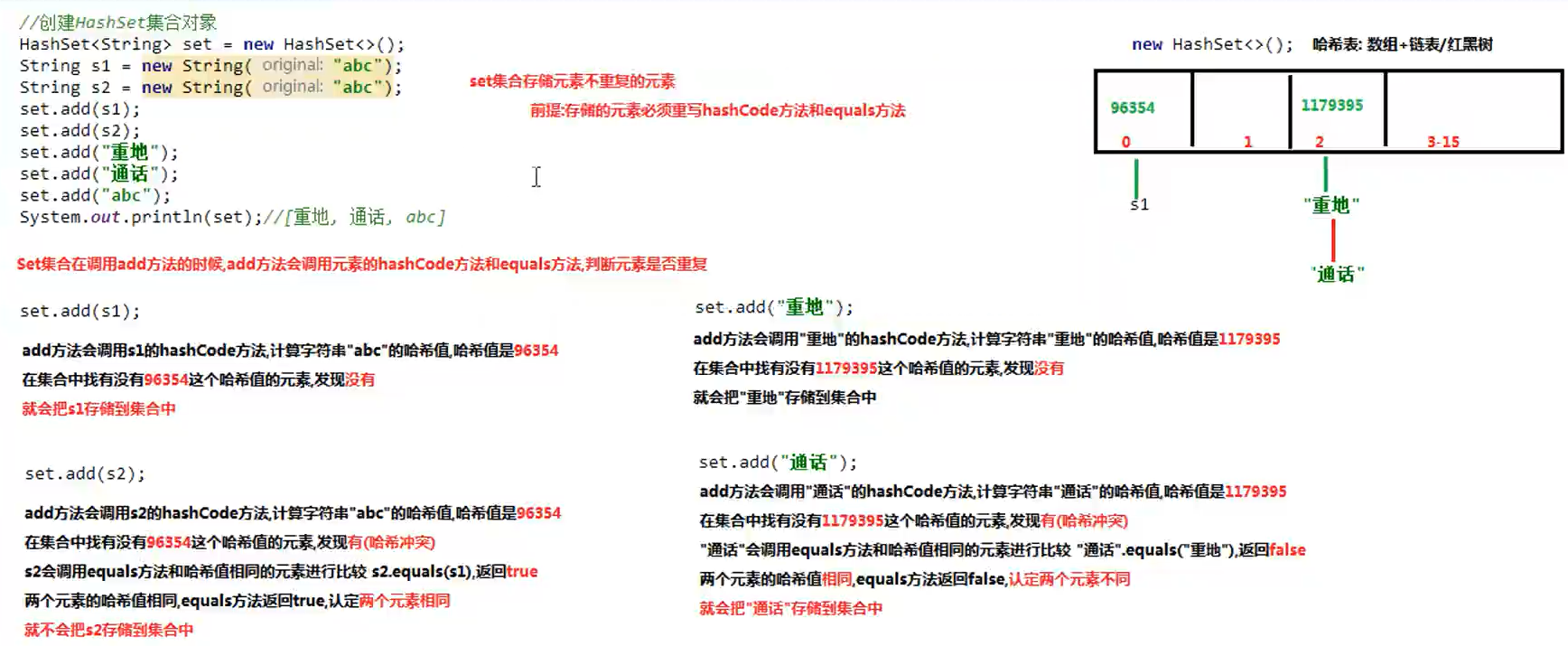『Java』List Set
观前提醒:本文内容多为入门时的学习笔记,笔记内容有些混乱!!!
| 😙 | 😎 | 😟 |
| 😙 | 😨 | 🤣 |
| 🐭 | 😯 | 😟 |
泛型只能是引用类型,不能是基本类型。
如果希望集合中存储的是基本类型数据,需要基本类型对应的“包装类”,如下:
基本类型 包装类(都位于java.lang包中)
byte Byte
short Short
int Integer
long Long
float Float
double Double
char Character
boolean Boolean
// 自动装箱:基本类型 --> 包装类型 例如:int --> Integer
// 自动拆箱:包装类型 --> 基本类型 例如:Integer --> int
List
List接口不但继承了Collection接口的全部方法,还增加了一些根据元素【索引】进行操作的特有方法,如下:
public void add(int index, E element):将指定元素添加到集合的指定位置public E get(int index):获取指定位置的元素值public E remove(int index):删除指定位置的元素值,返回被移除元素public E set(int index, E element):用指定元素替换指定位置的元素,返回指定位置的修改之前的元素
ArrayList
每个 ArrayList 实例都有一个容量,随着向 ArrayList 中不断添加元素,其容量也自动增长。
import java.util.ArrayList;
import java.util.Collection;
import java.util.Collections;
public class Main {
public static void main(String[] args) {
ArrayList<Integer> arr = new ArrayList<>(); // 定义一个空列表
ArrayList<Character> arr_char = new ArrayList<>(5); // 使用指定的初始容量构造一个空列表
System.out.println(arr_char.size()); // 0 返回集合中元素的个数,虽然arr_char容量为5,但是还没有元素
arr.add(0);
System.out.println(arr); // [0]
Collection<Integer> coll = new ArrayList<>();
Collections.addAll(coll, 1,2,3,4);
arr.addAll(coll);
System.out.println(arr); // [0, 1, 2, 3, 4]
arr.add(3, -1); // 在索引3的位置上插入元素10
System.out.println(arr); // [0, 1, 2, -1, 3, 4]
arr.addAll(0, coll); // 在0位置上插入coll中的元素
System.out.println(arr); // [1, 2, 3, 4, 0, 1, 2, -1, 3, 4]
System.out.println(arr.indexOf(-1)); // 7 返回-1元素的索引值
System.out.println(arr.get(7)); // -1 获取索引7对应的元素值
System.out.println(arr.set(7, 1)); // -1 将-1这个元素修改为1,并返回修改之前的元素
System.out.println(arr); // [1, 2, 3, 4, 0, 1, 2, 1, 3, 4]
System.out.println(arr.remove(7)); // 1 删除索引7对应的元素,并返回该元素
System.out.println(arr); // [1, 2, 3, 4, 0, 1, 2, 3, 4]
System.out.println(arr.subList(3, 6)); // [4, 0, 1] 截取索引在[3, 6)之间的元素,返回值是List<E>
arr.sort((o1, o2) -> o1 - o2); // 升序排列 无论升序还是降序都需要传入Comparator实现类的实例
System.out.println(arr); // [0, 1, 1, 2, 2, 3, 3, 4, 4]
arr.sort((o1, o2) -> o2 - o1); // 降序排列
System.out.println(arr); // [4, 4, 3, 3, 2, 2, 1, 1, 0]
System.out.println(arr.contains(0)); // true 集合中包含元素0,返回true
System.out.println(arr.containsAll(coll)); // true 如果该集合包含指定集合中的所有元素,则返回true
System.out.println(arr.removeAll(coll)); // true 删除arr中所有包含在coll中的元素
System.out.println(arr); // [0]
System.out.println(arr.isEmpty()); // false 判空
ArrayList arr2 = (ArrayList<Integer>)arr.clone(); // 拷贝,返回值是一个Object实例,可进行向下转型
System.out.println(arr == arr2); // false
arr2.clear(); // 将集合中元素清空
System.out.println(arr); // [0]
System.out.println(arr2); // []
}
}
LinkedList
LinkedList集合的特点:
- 底层是一个【链表】结构:查询慢,增删快
- 里边包含了大量操作首尾元素的方法
下面代码介绍几个LinkedList特有方法,其他List和Collection接口定义的一些共性方法不在介绍:
import java.util.LinkedList;
public class Main {
public static void main(String[] args) {
/* LinkedList中特有的一些重用方法:
- public void addFirst(E e):将指定元素插入此列表的开头。
- public void addLast(E e):将指定元素添加到此列表的结尾。
- public void push(E e):将元素推入此列表所表示的堆栈。
- public E getFirst():返回此列表的第一个元素。
- public E getLast():返回此列表的最后一个元素。
- public E removeFirst():移除并返回此列表的第一个元素。
- public E removeLast():移除并返回此列表的最后一个元素。
- public E pop():从此列表所表示的堆栈处弹出一个元素。
- public boolean isEmpty():如果列表不包含元素,则返回true。
*/
//创建LinkedList集合对象
LinkedList<String> linked = new LinkedList<>();
//使用add方法往集合中添加元素
linked.add("a");
linked.add("b");
linked.add("c");
System.out.println(linked); //[a, b, c]
// addFirst()等价于push()
linked.addFirst("www1");
System.out.println(linked); // [www1, a, b, c]
linked.push("www2");
System.out.println(linked); // [www2, www1, a, b, c]
// 将指定元素添加到此列表的结尾。此方法等效于add()
linked.addLast("com");
System.out.println(linked); // [www2, www1, a, b, c, com]
if(!linked.isEmpty()){ // 判空
String first = linked.getFirst(); // 获取表头元素
System.out.println(first); // www2
String last = linked.getLast(); // 获取表尾元素
System.out.println(last); // com
System.out.println(linked); // [www2, www1, a, b, c, com]
}
String first = linked.pop(); // 弹出第一个元素,相当于removeFirst()
System.out.println("被移除的第一个元素:"+first); // 被移除的第一个元素:www2
String last = linked.removeLast();
System.out.println("被移除的最后一个元素:"+last); // 被移除的最后一个元素:com
System.out.println(linked); // [www1, a, b, c]
linked.removeFirst();
System.out.println(linked); // [a, b, c]
linked.add(2, "bc"); // 可以使用索引
System.out.println(linked); // [a, b, bc, c]
System.out.println(linked.get(2)); // bc 通过索引获取元素
}
}
Set
Set集合特点:
- 不允许重复的元素
- 没有索引,不能使用带索引的方法
HashSet和LinkedHashSet
HashSet是Set接口的一个实现类,LinkedHashSet也是Set接口的一个实现类,同时还是HashSet的子类。
HashSet的常用方法:
public boolean add(E e)
public boolean remove(Object o)
public void clear()
public boolean contains(Object o)
public boolean isEmpty()
public boolean isEmpty()
// 以上方法不再介绍
import java.util.*;
public class Main {
public static void main(String[] args) {
/*
java.util.HashSet 是 Set接口 的一个实现类
特点:
1. 无序集合,存储顺序和取出顺序可能不一致
2. 底层是一个哈希表,查询速度非常快
*/
Set<Integer> set1 = new HashSet<>();
set1.add(1); set1.add(3); set1.add(2); set1.add(1);
System.out.println(set1); // [1, 2, 3]
// 遍历方式:
Iterator<Integer> it = set1.iterator(); // 返回该集合中所有元素的迭代器
while (it.hasNext()){ // hasNext()判断是否还有下一个元素
System.out.println(it.next()); // next()获取下一个元素
} // 1 2 3
// 使用foreach语句遍历集合
for (int x : set1)
System.out.println(x); // 1 2 3
// ===============================================================
/*
java.util.LinkedHashSet是HashSet的一个子类
底层结构是【哈希表+链表】,链表用来记录元素添加顺序,可以实现顺序存储
*/
Set<Integer> set3 = new LinkedHashSet<>();
set3.add(1); set3.add(3); set3.add(2); set3.add(1);
System.out.println(set3); // [1, 3, 2]
}
}
哈希表图解

Set集合中元素不重复的原理



 浙公网安备 33010602011771号
浙公网安备 33010602011771号